The Amazing Spider-Man #302: “(Mid) American Gothic”
This issue answers the inevitable question of what would happen if a man gained the proportional strength of the radioactive jackrabbit who bit him. Also, Peter Parker considers a longer commute to work.
Kickin’ Credits
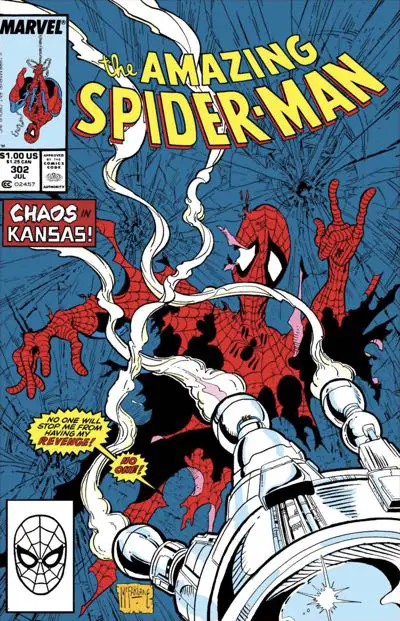
Pencils: Todd McFarlane
Inks: Todd McFarlane
Colors: Gregory Wright
Letterer: Rick Parker
Publication Date: March 8, 1988
Peter Parker’s Career Struggles
From the start of The McSpidey Chronicles, David Michelinie has returned to the idea that the common man, Peter Parker, has married a superstar model in Mary Jane, and has stressed about it. It’s not a misogynistic thing or a sign of the times. It’s human nature that the disparity of incomes in this new marriage leads the one on the “short end” of the stick to have doubts about his contributions to the marriage.
When the partner brings home so much of the bacon, one might feel guilty eating such crispy salty goodness. (Pushing the metaphor too far? Yeah, sorry. Didn’t mean to ham it up.)
In previous issues, we’ve seen Peter be unacceptably risky in his dealings with a villain to get a better photograph and more money. That mistake nearly cost someone their life. Mary Jane has sensed his frustrations and suggested a new professional angle on his photography. Robbie Robertson suggested he get out of the newspaper photography game altogether! Peter considered going back to school to sharpen his photographic skills.
One of the subplots I didn’t mention in my write-up of issue #301 is that Peter was being followed by a man who had a tough time catching up with him. At the end of the issue, it was revealed that he was there to offer Peter a job at a facility in Kansas as a “Chief Assistant” (presumably to something science-related). He was recommended there by Dr. Curt Conners, better known as The Lizard.
David Michelinie has said that it was McFarlane’s single drawing of the Lizard at the end of #301 that caused him to write a story a LIzard story for “The Amazing Spider-Man” #313. McFarlane, of course, would go even further and feature The Lizard in the first story arc of his adjectiveless Spider-Man series.
There is no Lizard in this story, though.
There is, however, Silver Sable and Sandman. They appear on one page to bridge the storyline from the last issue to the follow-up that will happen in the next. They’re just getting the gang together to go after the Nazi.
Back to Peter:
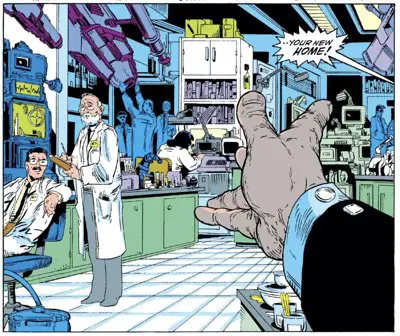
Peter has a new job offer on the table, appealing to his scientific side. It’s with an outfit named “On-Line Research,” a generic research lab for scientific studies that fits a perfect little mold in the world of comic books. (Keep in mind that this book was written in 1988. “On-line” wasn’t synonymous with the internet yet. Netscape was still six years away.) It’s generic enough to encompass just about anything and provides lots of angles for the imaginative writer to fill out stories.
While that helps set up the action of the issue, the real drama is at the end, when Peter gets excited about the job and wants to take it. Did I mention that the job is in Kansas? And that Mary Jane doesn’t want to leave New York and her growing modeling career?
This is 1988. “Work From Home” wasn’t a big thing yet. This is yet another plot point that’s a classic set-up of dramas that doesn’t work as easily today. It still happens, but you need to explain it in greater detail to sell it.
But it is the tension for this issue and what comes next. I can’t wait to see how it plays out next issue. I remember enough that he doesn’t take the job — or at least doesn’t last long there — but I’m drawing a blank on the details.
This is a plot point that helps bring new drama to the new marriage while building on the themes of previous issues. The characters have been forced in two different directions for very logical reasons, and now that looks to be hitting a breaking point. Someone will lose on this one. That’s exciting from a reader’s point of view, even if the execution is very surface level and happening in support of some costumed villain of the month story.
This issue also shows off a superpower I’ve never seen Spider-Man do before: 3D printed voodoo dolls made of webbing!
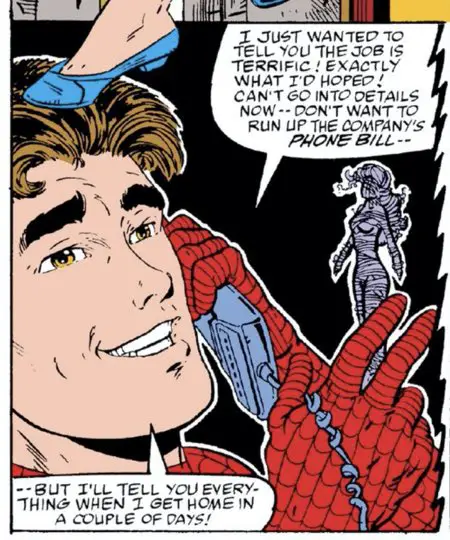
And, yes, there was a time when long-distance calls were a thing, and they cost you extra on your phone plan.
The Superhero Plot
In this issue, the villain is a rogue scientist looking to use his research to create a weapon to get his revenge on past professional wrongs. He’s secondary to the story, though.
The real star of this story is Wes Cassady, the construction foreman at On-Line Research’s new building. He’s no relation to Carnage, who was still a few years away and spells it “Kasady”. Michelinie must have liked the sound of that name and wanted someone with it to break out. He got his wish eventually!
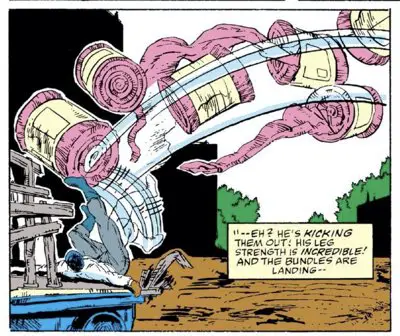
Cassady has mysterious super-speed powers and a powerful kick (seen above as he kicks insulation into place to stop a fire). When Spider-Man confronts him, he shares his origin story. Michelinie is in on the joke. He makes sure to position Cassady in such a way that he’s almost embarrassed by his origin story and knows it’s going to sound like a joke.
He doesn’t want to be seen as a freak. Unlike everyone else in the Marvel Universe who discovered their powers, Cassady didn’t even create a costume of his own, or give himself a nickname.
First: What a relief to have a different kind of story, one where the guy with powers doesn’t want to hide or fight the guy who’s there to potentially help him. He’s relieved to have someone to listen to him. It’s just… nice. It’s not an initial misunderstanding followed by a team-up against a stronger adversary.
Cassady seems like a nice guy — a natural leader of men and a family man, but someone who has to hide something that’s hurting him inside, more emotionally than physically. Spider-Man gives him the chance to vent, spill the beans, and use his power for good.
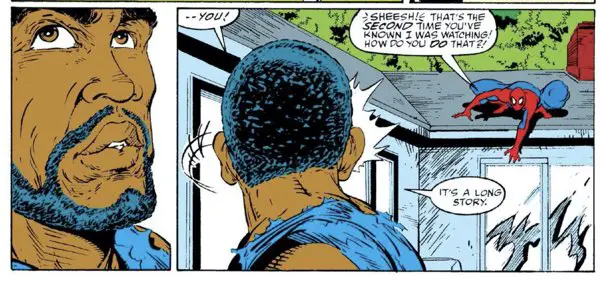
Well, almost. The big moment in the story comes at the end, where Spider-Man needs Cassady’s help against the scientist’s weapon, but Cassady doesn’t do it for fear of revealing his powers to everyone else.
Spider-Man manages to win the day without the help in the end, though, and walks away.
When I initially reviewed this story a few years back, I wrote:
The problem with this story is that Spider-Man comes off as cold and useless. He listens to Cassady, but never shares with him his very similar experience. Spider-Man listens to him, tells him there’s nothing he can do to help, and swings away just happy that Cassady never asked him what he was doing in Kansas. And when Cassady passes on his big moment on the end, Spider-Man gives him a two line lecture and walks away. We never will know what became of Cassady.
So what’s the point of the story? Cassady doesn’t change anything. He doesn’t have any change of heart. He is forced to make a decision at the end, but the results of it will forever be unknown. There are no consequences shown to the viewer, aside from a minor guilt trip. […]
In the end, he’s a guy who was bitten by a radioactive jackrabbit and gained strong kicking skills. Maybe the less we know about him, the better. But I think he’s one of the more interesting and unique characters in the series so far. A bit mopey and depressed, but a character who could be changed greatly by his own actions or in-actions. We just never see the results. Frustrating.
I have a completely different reaction to the story this time around. To me, the decision at the end of the story shows Cassady in a very realistic and very believable light. It’s not an easy one. He agonizes over it, but Spider-Man will be leaving town after this, and he still has to lead his life.
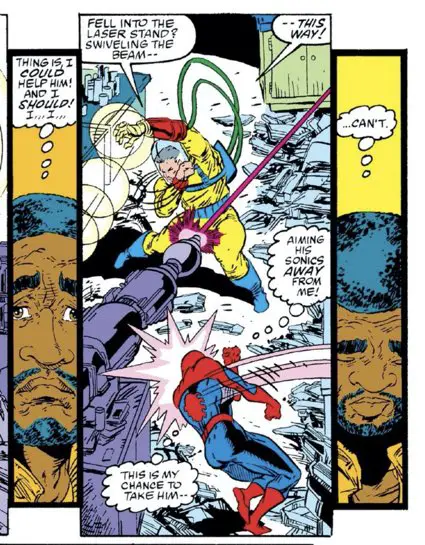
There are likely more people like Cassady in the Marvel Universe: people with powers who don’t want to do anything with them. They hide them. Most people won’t ever have a moment like Cassady has here, where their powers could save someone’s life. And so their lives remain quiet and simple. That’s enough for most.
When you read enough superhero comics, you begin to think in the augmented way that the characters in these stories usually think. What would you do with these powers? Most likely, you wouldn’t patrol your hometown at night looking to scare off bad people in the midst of crimes.
Michelinie’s ending strikes me as a bit more realistic than good old-fashioned superheroism. It is the kind of story that makes you think about things more. I appreciate the way Michelinie swerved away from the obvious ending here, creating something that some might view as tragic, but others might view as a good prompt for discussion.
Spider-Man’s reaction at the end is equally honest. He’s not happy with Cassady’s response. Spider-Man barely made it out of that fix. But he also understands it.
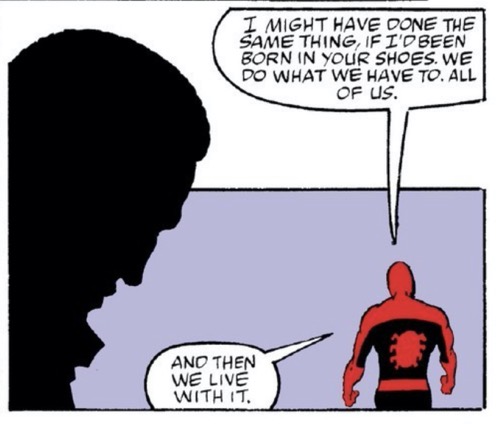
But he does put in that little dig at the end. Ouch. It is a little bit like not sending the bad guy to jail because he did something along the way that was bad for him, too. (“You’ll have to live with yourself now. That’s torture enough.”)
Curiously, Cassady has not been seen again. He’s the kind of character I’d expect Dan Slott to bring back. Hey, if Squirrel Girl and Slapstick could come back, why not “Bunny Man,” as he’s nicknamed on Marvel’s Wiki?
McFarlane Bounces Back
McFarlane’s art in this issue is stronger than the last issue’s.
He has a better and more consistent handle on the faces he’s drawing repeatedly here. Spider-Man is getting more acrobatic again in his aerials. The inking looks busier. The little details like the webbing in the gutters are starting to show up.
McFarlane is still feeling his way around Spider-Man’s costume. The webbing pattern is competent, but not stylistic yet. And the inking in the blue areas of the costume is much more simplified than it would later get. It’s not a bad look, but it seems like more of a throwback than anything else.
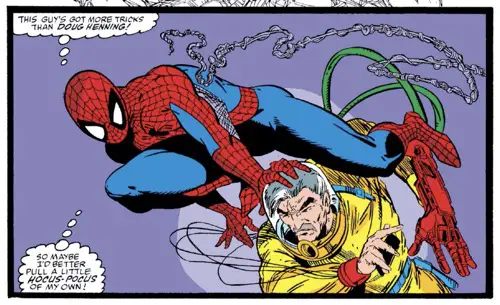
The weakest page of the issue by far is the ninth story page. It features Silver Sable training in the Symkarian Embassy. The page looks like it was churned out in an hour. It sticks out like a sore thumb in the issue, like someone miscounted the pages done for the issue and had to throw this in at the last minute to keep the page count up. There are basically no backgrounds, no thin lines in the inks, and a boring layout.
While McFarlane is getting stronger on the series as the months fly by, he’s still inconsistent. (There’s a Sandman head also in the issue that’s way out of proportion, and lumpy.) We haven’t yet seen the full McSpidey.
From a Different Corporate Era
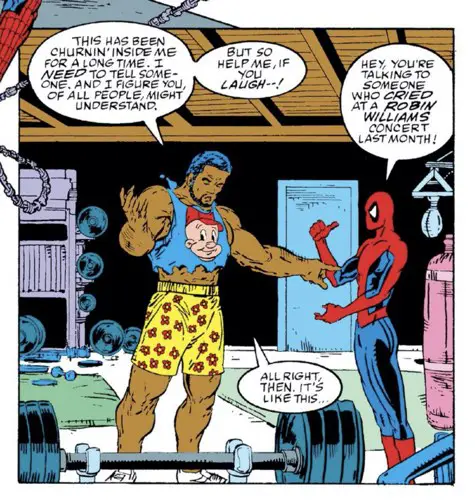
Cassady wears a prominent Elmer Fudd shirt in the issue. Warner Bros bought DC Comics more than 20 years earlier. I wonder if there was a reason McFarlane chose that t-shirt… I can’t imagine Disney’s lawyers or marketing department ever letting that one slip by today.
Heck, I can show you a page of original “Birds of Prey” art that Greg Land drew with a Pinky and the Brain mug that got cut out. And those two IPs have the same corporate parentage!
At least Spider-Man’s Robin Williams line aged better than his earlier Doug Henning reference.
Finding Felix
He’s on story page 16 of the digital comic. If you’re looking at the original issue, that should be page 20.
Once again, we’re going to need CSI to zoom-and-enhance the following image:
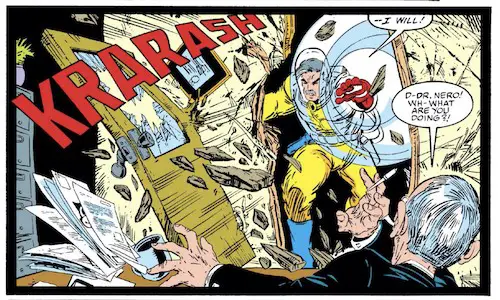
Yup, there’s Felix, hiding in some paperwork in the bottom left:
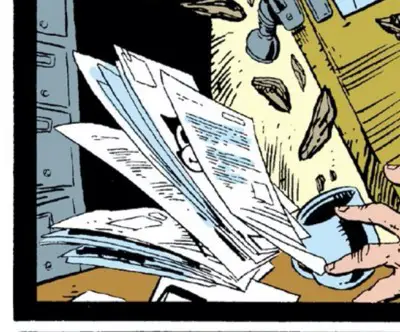
It does make you wonder just what kind of study “On-Line Research” was doing with Felix the Cat as a test subject. This was 1988. I have no doubt they were using animals for their research.
The Corner Box Story
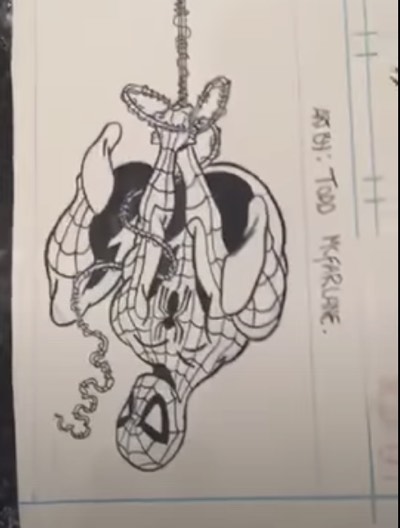
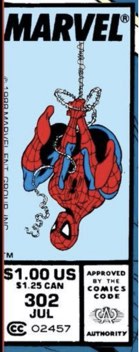
Up until this point, Marvel used the previous corner box art on McFarlane’s issues. This is where it changes from a running Spider-Man drawn by a different artist to McFarlane’s Spider-Man, hanging from his webbing in a more insect-like crouching position. Being upside down is also cool and in character.
In 2017, Todd McFarlane posted a video showing the original art from the corner box. The art was returned to him from Marvel in 2011, more than twenty years after he originally sent it in.
I’ve heard those stories in the past about long-thought-lost art showing up at Marvel or DC’s offices and being returned to the artist, but this is the first time I’ve seen it. That’s pretty cool. I’m sure this little drawing would go for big bucks in the open market these days.
As McFarlane points out in the video, the corner box image would be later updated to include more of his linework into the image — some scratches on Spider-Man’s feet and more webbing on the costume. That started to appear with issue #327 of the series, which is an issue McFarlane didn’t even draw. His run ended with issue #328.
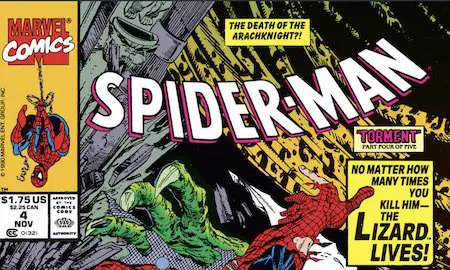
Funny enough, the original art seen above was also used on the covers of the adjective-less “Spider-Man” series from issue #1 through issue #4. Someone must have realized they were using the old art at that point and switched to the updated, more detailed line work with issue #5 again.
Final Analysis
It’s a goofy issue in some ways, yet how are the powers of a radioactive jackrabbit any nuttier than the powers of a radioactive spider?
The truth is, it’s a nice done-in-one story of a man who has to make a tough decision in a key moment. He doesn’t do the heroic thing, like I don’t think a lot of people would.
It’s not a morality play, nor is it a tragedy. It’s a story that surprisingly doesn’t go for the jugular one way or the other. It’s a nice character study with an uncomfortable ending. I like it.
The Elmer Fudd shirt didn’t hurt, either.
BD Recommendation
If you liked this issue, I have a recommendation for you from the world of les bandes dessinées, or Franco-Belgian comics.
This book almost feels like a parody of superhero comics. It doesn’t get sillier than the powers of a jackrabbit, right? (Unless you count all the other animal-themed characters Steve Ditko created for the series 30 years prior.)

They don’t do much in the way of superheroics in Franco-Belgian comics, but the eighth volume in the Valerian and Laureline series, “Heroes of the Equinox”, is a clear take on American superheroes as filtered through some French brains.
Everything from the display of powers to the creative page layouts and the costumes gives this science fiction series a decidedly superheroic bent for one book.
It isn’t exactly a parody, but it is a lot of fun. You can read my review of “Heroes of the Equinox” here.
In The Next Issue
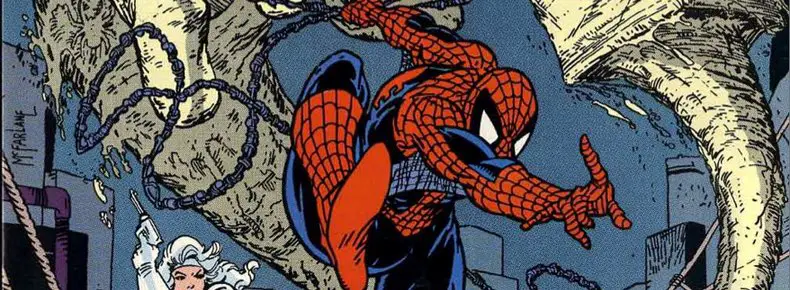
More Silver Sable, more Nazis, Sandman, and Mary Jane in her unmentionables, again.
We also start looking for hidden cover spiders! Check it out now!
Bonus Mary Jane Faux Jealousy Panel
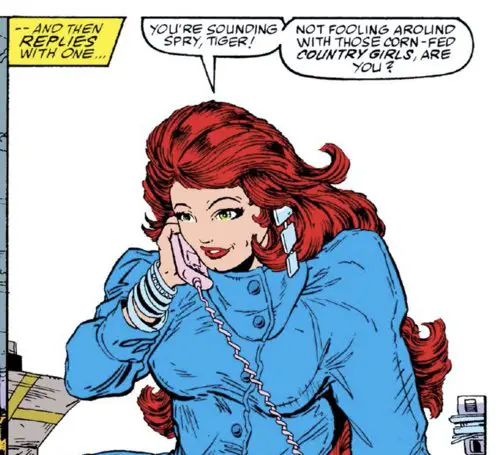
“You know, Peter, those corn-fed country girls got them child-bearing hips, so be careful. Also, these puffy shoulders are going to come back in thirty years, just you wait and see!”

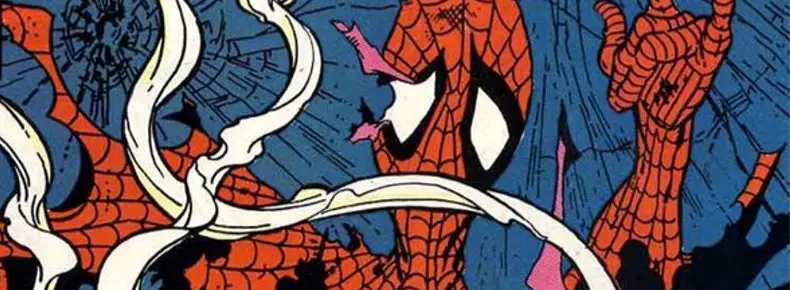
2 Comments